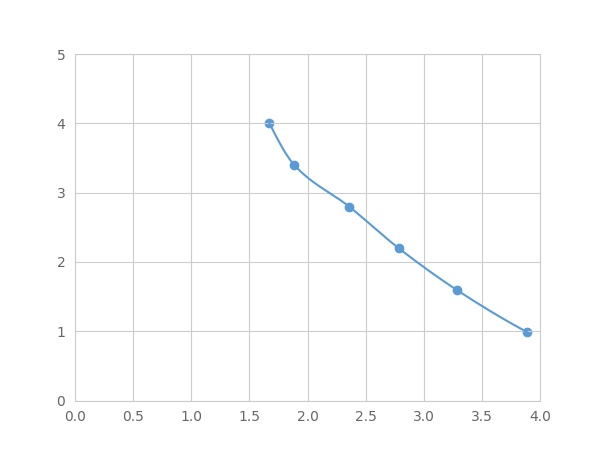Packages (Simulation)

Reagent Preparation

Image (I)
Image (II)
Certificate


Multiplex Assay Kit for Retinol (Ret) ,etc. by FLIA (Flow Luminescence Immunoassay)
VA; Vitamin A; Aquasola
(Note: Up to 8-plex in one testing reaction)
- Product No.LMD051Ge
- Organism SpeciesPan-species (General) Same name, Different species.
- Sample Typeserum, plasma and other biological fluids
- Test MethodCompetitive Inhibition
- Assay Length1.5h
- Detection Range9.77-10000ng/mL
- SensitivityThe minimum detectable dose of this kit is typically less than 3.257 ng/mL.
- DownloadInstruction Manual
- UOM 8Plex 7Plex 6Plex 5Plex 4Plex 3Plex 2Plex1Plex
- FOB
US$ 509
US$ 529
US$ 558
US$ 597
US$ 636
US$ 695
US$ 783
US$ 979
Add to Price Calculator
Result
For more details, please contact local distributors!
Specificity
This assay has high sensitivity and excellent specificity for detection of Retinol (Ret) ,etc. by FLIA (Flow Luminescence Immunoassay).
No significant cross-reactivity or interference between Retinol (Ret) ,etc. by FLIA (Flow Luminescence Immunoassay) and analogues was observed.
Recovery
Matrices listed below were spiked with certain level of Retinol (Ret) ,etc. by FLIA (Flow Luminescence Immunoassay) and the recovery rates were calculated by comparing the measured value to the expected amount of Retinol (Ret) ,etc. by FLIA (Flow Luminescence Immunoassay) in samples.
| Matrix | Recovery range (%) | Average(%) |
| serum(n=5) | 94-105 | 99 |
| EDTA plasma(n=5) | 86-104 | 92 |
| heparin plasma(n=5) | 94-103 | 97 |
Precision
Intra-assay Precision (Precision within an assay): 3 samples with low, middle and high level Retinol (Ret) ,etc. by FLIA (Flow Luminescence Immunoassay) were tested 20 times on one plate, respectively.
Inter-assay Precision (Precision between assays): 3 samples with low, middle and high level Retinol (Ret) ,etc. by FLIA (Flow Luminescence Immunoassay) were tested on 3 different plates, 8 replicates in each plate.
CV(%) = SD/meanX100
Intra-Assay: CV<10%
Inter-Assay: CV<12%
Linearity
The linearity of the kit was assayed by testing samples spiked with appropriate concentration of Retinol (Ret) ,etc. by FLIA (Flow Luminescence Immunoassay) and their serial dilutions. The results were demonstrated by the percentage of calculated concentration to the expected.
| Sample | 1:2 | 1:4 | 1:8 | 1:16 |
| serum(n=5) | 80-103% | 90-97% | 85-101% | 85-102% |
| EDTA plasma(n=5) | 78-91% | 79-104% | 79-94% | 84-91% |
| heparin plasma(n=5) | 80-91% | 83-98% | 80-104% | 89-97% |
Stability
The stability of kit is determined by the loss rate of activity. The loss rate of this kit is less than 5% within the expiration date under appropriate storage condition.
To minimize extra influence on the performance, operation procedures and lab conditions, especially room temperature, air humidity, incubator temperature should be strictly controlled. It is also strongly suggested that the whole assay is performed by the same operator from the beginning to the end.
Reagents and materials provided
| Reagents | Quantity | Reagents | Quantity |
| 96-well plate | 1 | Plate sealer for 96 wells | 4 |
| Pre-Mixed Standard | 2 | Standard Diluent | 1×20mL |
| Pre-Mixed Magnetic beads (22#:Ret) | 1 | Analysis buffer | 1×20mL |
| Pre-Mixed Detection Reagent A | 1×120μL | Assay Diluent A | 1×12mL |
| Detection Reagent B (PE-SA) | 1×120μL | Assay Diluent B | 1×12mL |
| Sheath Fluid | 1×10mL | Wash Buffer (30 × concentrate) | 1×20mL |
| Instruction manual | 1 |
Assay procedure summary
1. Preparation of standards, reagents and samples before the experiment;
2. Add 50μL standard or sample to each well,
add 10μL magnetic beads,and 50μL Detection Reagent A,incubate 60min at 37°C on shaker;
3. Wash plate on magnetic frame for three times;
4. Add 100μL prepared Detection Reagent B, and incubate 30 min at 37°C on shaker;
5. Wash plate on magnetic frame for three times;
6. Add 100μL sheath solution, swirl for 2 minutes, read on the machine.
GIVEAWAYS
INCREMENT SERVICES
| Magazine | Citations |
| Int.J.Pharm.Med.& Biol.Sci. | Effects of Vitamin A Overdose on the Immune system in rats Jpmbs: Source |
| BioMed Research International | Salivary 1, 5-Anhydroglucitol and Vitamin Levels in Relation to Caries Risk in Children |
| Archives of Gynecology and Obstetrics | Oxidative stress indicators in Chinese women with PCOS and correlation with features of metabolic syndrome and dependency on lipid patterns Pubmed: 31549221 |
| Prooxidant effect of α-tocopherol in pancreatic tumors. | |
| Vitamin A, C, D, E and B12 Levels in Leprosy: A Case Control Study | |
| BMJ Open | Protocol: Prevalence of specific micronutrient deficiencies in urban school going children of India aged between 6 and 16 years: study protocol for a … Pubmed:34907037 |
| PLoS One | Prevalence of specific micronutrient deficiencies in urban school going children and adolescence of India: A multicenter cross-sectional study Pubmed:35544476 |
| Clin Nutr Open Sci | Retinol Depletion in COVID-19 Pubmed:35664529 |
| Catalog No. | Related products for research use of Pan-species (General) Organism species | Applications (RESEARCH USE ONLY!) |
| CPD051Ge11 | BSA Conjugated Retinol (Ret) | Immunogen; SDS-PAGE; WB. |
| CPD051Ge21 | OVA Conjugated Retinol (Ret) | Immunogen; SDS-PAGE; WB. |
| PAD051Ge01 | Polyclonal Antibody to Retinol (Ret) | ELISA, CLIA. / IHC-Fr, ICC, IP (predicted). |
| LAD051Ge71 | Biotin-Linked Polyclonal Antibody to Retinol (Ret) | Applications: WB; IHC; ICC; IP. |
| CED051Ge | ELISA Kit for Retinol (Ret) | Enzyme-linked immunosorbent assay for Antigen Detection. |
| LMD051Ge | Multiplex Assay Kit for Retinol (Ret) ,etc. by FLIA (Flow Luminescence Immunoassay) | FLIA Kit for Antigen Detection. |
| KSD051Ge11 | ELISA Kit DIY Materials for Retinol (Ret) | Main materials for "Do It (ELISA Kit) Yourself". |




